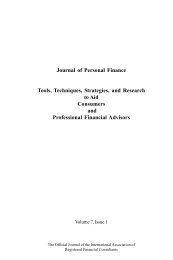Originator: Positive Mental Attitude W. Clement Stone - iarfc
Originator: Positive Mental Attitude W. Clement Stone - iarfc
Originator: Positive Mental Attitude W. Clement Stone - iarfc
Create successful ePaper yourself
Turn your PDF publications into a flip-book with our unique Google optimized e-Paper software.
Bankruptcy Awareness<br />
When the new bankruptcy law passed in<br />
2005, critics vigorously attacked the<br />
legislation. Consumer advocates,<br />
bankruptcy attorneys and some<br />
lawmakers blasted the act as unfair and<br />
anti-consumer. But supporters of the<br />
Bankruptcy Abuse Prevention and<br />
Consumer Protection Act, which went into<br />
effect in October, counter that the law's<br />
demands are reasonable and address a<br />
mushrooming problem with bankruptcy<br />
fraud that was costing consumers billions<br />
of dollars.<br />
“This bill would not have gotten anywhere<br />
if it was as extreme as the critics are<br />
trying to make it out to be,” says Pete<br />
Lawson, director of congressional and<br />
public affairs at the U.S. Chamber of<br />
Commerce in Washington, D.C. Others<br />
argue that it is too early to evaluate the<br />
law's impact since it is less than a year<br />
old. “Those who would have been<br />
adversely affected by the law most likely<br />
have filed prior to the law going into<br />
effect,” commented Todd Zywicki, visiting<br />
professor of law at Georgetown University<br />
Law Center.<br />
people are filing because of<br />
economic distress. What seems to<br />
have changed is the willingness for<br />
people to file. Bankruptcy laws have<br />
previously been so generous that<br />
they have provided people with<br />
greater incentives to file.”<br />
Secondly, the change in social norms<br />
and social stigma have reduced or<br />
removed the degree of disapproval of<br />
bankruptcy. This seems to be the<br />
largest examples given the lack of<br />
other economic variables. Stuart<br />
Feldstein, of SMR Research says,<br />
“The database has shown that once<br />
a place develops a very high filing<br />
rate, it typically stays high no matter<br />
what improvements occur in the local<br />
economy. Memphis is a prime<br />
example. The only possible<br />
explanation was loss of stigma<br />
attached to bankruptcy. That is, once<br />
bankruptcy becomes very common<br />
and everyone knows someone who<br />
has filed, a bankruptcy filing no<br />
longer seems very mysterious,<br />
embarrassing or shameful.”<br />
The cause for filings. Consumer<br />
advocates argue that most bankruptcies<br />
are caused by medical problems,<br />
unemployment or divorce. Proponents of<br />
the new law acknowledge these factors<br />
play a role, but say they are greatly<br />
overstated. A national bankruptcy<br />
database identified no correlation<br />
between bankruptcy rates and<br />
unemployment rates, but it found a close<br />
correlation with a number of other factors.<br />
Among them were the percentage of<br />
adults who were divorced, the percentage<br />
of the population not covered by health<br />
insurance, overall consumer debt levels,<br />
ages, nearness of gambling casinos,<br />
lawyer advertising, minimum auto<br />
insurance coverage requirements by state<br />
and growth of adjustable-rate consumer<br />
debt.<br />
The bankruptcy database compares<br />
bankruptcy rates in local areas to other<br />
available economic and social statistics<br />
from the Census Bureau, the Bureau of<br />
Labor Statistics and other sources. You<br />
can search for which economic and social<br />
data actually correlated with high or low<br />
bankruptcy rates. Zywicki argues that<br />
there are other factors that play a<br />
significant role: unemployment has been<br />
low; divorce rates have been falling and<br />
interest rates are relatively low. “We've<br />
had 20 years of economic growth, yet<br />
Misuse of the law. Supporters of<br />
the law frequently cite fraud as the<br />
catalyst for change and point to findings<br />
by the Federal Bureau of Investigation,<br />
which estimated that 10 percent of<br />
bankruptcies have involved fraud, with<br />
“hiding of assets” as the most common<br />
type. Feldstein believes that percentage<br />
is an understatement based on<br />
bankruptcy petitions his researchers have<br />
examined. He says the researchers found<br />
numerous incidents where the person's<br />
income was actually much higher than<br />
stated. “A man on one petition we read<br />
owed a single large debt for the purchase<br />
of a hot tub,” says Feldstein. “He sought<br />
to have this debt and others expunged,<br />
but he also claimed he no longer had the<br />
hot tub, so it could not be repossessed<br />
and sold. He claimed it had been stolen.<br />
We found that claim stretched credibility,<br />
since a typical hot tub contains about 400<br />
gallons of water, weighing about 3,200<br />
pounds, takes several hours to drain, and<br />
even when drained requires at least six<br />
men to lift and move. You would need a<br />
team of thieves, a large truck and a full<br />
day time to commit this theft.”<br />
on Banking, Housing and Urban Affairs on<br />
March 25, 1999, a banker from New York<br />
said that a lawyer in his area advised<br />
clients to pay their non-dischargeable debt<br />
with credit card cash advances and then<br />
file Chapter 7. The credit card balances,<br />
which are unsecured debt, could then be<br />
discharged. “The system had gotten to a<br />
point where, some wealthy people were<br />
using it as a financial planning tool,” says<br />
Laura Fisher, spokeswoman for the<br />
American Bankers Association, which<br />
represents financial institutions. The<br />
American Bankers Association estimates<br />
that 5 percent to 10 percent of bankruptcy<br />
filers under the new system will have to<br />
pay more of what they owe.<br />
Tightening credit terms. Proponents say<br />
costs resulting from the abuse ultimately<br />
mean higher down payments, higher<br />
interest rates and higher costs for goods<br />
and services. Mallory Duncan, lobbyist for<br />
the National Retail Federation in<br />
Washington, D.C., says a lot of retailers<br />
extend credit to customers. When a<br />
customer files for Chapter 7 bankruptcy<br />
the retail cards get wiped out. “When a<br />
customer wipes out the two or three<br />
hundred dollars, that isn't going to hurt<br />
the local retailer. But if tens of thousands<br />
or even if millions of people are doing it,<br />
Many advocates for the reformed<br />
bankruptcy law argue that consumers<br />
“gamed the system” too often. In<br />
testimony from the American Bankers<br />
Association before the Senate Committee<br />
continued on page 16<br />
The Register • August 2006 Page 15
















